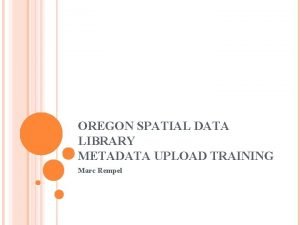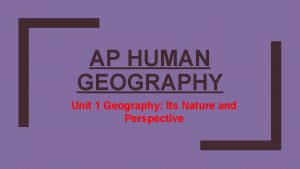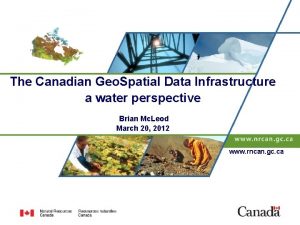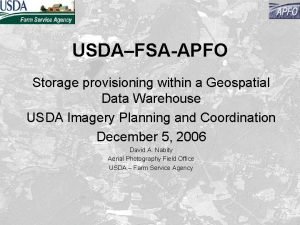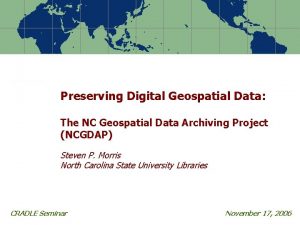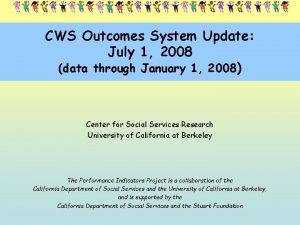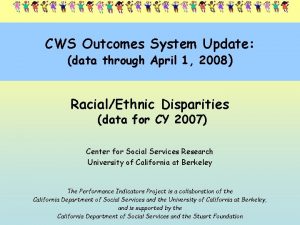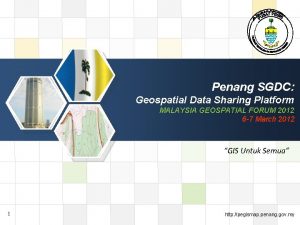CHALLENGES AND OPPORTUNITIES IN HARMONIZING CWS GEOSPATIAL DATA










- Slides: 10

CHALLENGES AND OPPORTUNITIES IN HARMONIZING CWS GEOSPATIAL DATA MODERNIZING SPATIAL DATA INFRASTRUCTURE (SDI) FOR CUMULATIVE EFFECTS WORKSHOP Environment and Climate Change Canada (ECCC) Canadian Wildlife Service (CWS) Souleymane TOURE September 10, 2021

BACKGROUND & CONTEXT The Canadian Wildlife Service (CWS) is an organization with a long-standing mission of scientifically driven conservation and environmental regulation in Canada, focused on improving conservation outcomes for Canadians The mandate of CWS centers around the delivery of three Departmental Results for the benefit of Canadians (CWS’ Strategic Priorities): • Canada’s wildlife and habitat are conserved and protected; • Canada’s species at risk are recovered; and, • Indigenous Peoples are engaged in conservation CWS has developed an Information and Data Management Strategy and Implementation Plan with early engagement efforts completed in the summer of 2020 The CWS’ Information and Data Management Strategy is foundational to transforming our IM and IT infrastructure to enable CWS programs to deliver on Cumulative Effects Initiative, Nature Legacy, Nature Based Climate Solutions, and wildlife conservation agenda 2

CWS INFORMATION & DATA MANAGEMENT STRATEGY Governance of Information and Data Enabling environment and IT infrastructure Information and data as a strategic asset 3 • Information and data is managed as a strategic asset by clarifying accountabilities, roles, and responsibilities. • Appropriate tools, infrastructure and processes are available to turn information and data into insights and actions. • CWS has access to the information and data it needs in a manner that is fit for use, discoverable, and available to support decisionmaking.

CWS KEY DATA LAYERS FOR THE CUMULATIVE EFFECT INITIATIVE • CWS contributes to the Cumulative Effects Initiative with these key data layers: 1. 2. 3. 4. 5. Canadian Protected and Conserved Areas Database (CPCAD) ECCC Critical Habitat Project Canadian Terrestrial Ecological Framework (CTEF) Key Biodiversity Areas (KBA) Canadian Wetlands Inventory Database 4

CWS DATA HARMONIZATION CHALLENGES & SOLUTIONS Challenges Mitigation Measures 1. Accounting for all CWS data 1. Creating the CWS data inventory 2. Discordant data schema 2. Implementing national data schema 3. Tracking data sharing agreements 3. Creating data sharing standards 4. Managing sensitive wildlife data 4. ECCC sensitive wildlife data policy 5. Translation cost of Metadata 5. Standardizing the metadata 5

THE CANADIAN WETLANDS DATABASE • Combine Canada’s best available wetlands datasets from various sources into a single, consolidated, and seamless wetlands data layer at the national scale • Develop the Canadian wetlands indicators to support the Canadian Environmental Sustainability Indicators (CESI) initiative: • Canadian Wetlands Extent Map (Done) • Amount of wetland in Canada • Type and location of wetlands • Canadian Wetlands Trend Indicators (in progress) • Wetlands Change Speed • Wetlands Change Intensity • Support CWS’ mandate and programmes (Mig. Birds, PA, Species & Habitats) • Populate the Federal Geospatial Platform (FGP), Open Science Data portal (OSDP) and contribute to the Federal Sustainable Development Strategy (FSDS) 6

HARMONIZING MULTI-DATE, SOURCES & SCALE DATASETS Wetlands Not Identified Bog Fen Marsh Shallow Water Swamp Based on the Canadian Wetland Classification System (1997) Multi-source, Multi-scale and Multidate datasets: F/P/T-NGO-Private 7

THE BEST AVAILABLE WETLANDS DATA • The current consolidated wetlands datasets at the national scale have around 15 million polygons (5. 3 GB) and it will continue to grow in size and scope with the gathering of new datasets. More than 30 data sources (Province/Territories/NGOs): Multi-source, Multi-scale and Multi-date datasets 8 Currently, only 25% of national wetlands coverage has been captured in the inventory or is in-progress across the country

CANADIAN WETLANDS EXTENT INDICATOR 10 km x 10 km Grid 9 Wetlands Data Published to these Websites: FGP and Open Maps

KEY MESSAGES • CWS is collaborating with NRCan to identify priority datasets to publish on the OSDP as part of the Cumulative Effects Initiative • The CWS Information and Data Management Strategy will facilitate the harmonization of our data holdings as well as support increased internal use and external publication of our data • A cultural shift is under way at CWS to optimize data and information governance, using the FAIR guiding principle for scientific data management and stewardship - Findability, Accessibility, Interoperability, and Reusability 1 1 Wilkinson, M. , Dumontier, M. , Aalbersberg, I. et al. The FAIR Guiding Principles for scientific data management and stewardship. Sci Data 3, 160018 (2016). https: //doi. org/10. 1038/sdata. 2016. 18 10
 Dcloud.cisco.com
Dcloud.cisco.com Opportunities and challenges in media
Opportunities and challenges in media Greater bay area opportunities and challenges
Greater bay area opportunities and challenges Asprs accuracy standards for digital geospatial data
Asprs accuracy standards for digital geospatial data Oregon geospatial data library
Oregon geospatial data library Dot density map definition ap human geography
Dot density map definition ap human geography John williams mit
John williams mit Canadian geospatial data infrastructure
Canadian geospatial data infrastructure Remote sensing ap human geography
Remote sensing ap human geography Usda geospatial data warehouse
Usda geospatial data warehouse Big data: issues, challenges, tools and good practices
Big data: issues, challenges, tools and good practices




